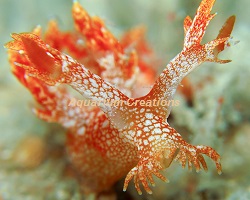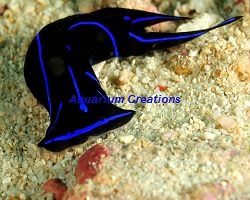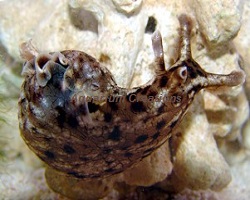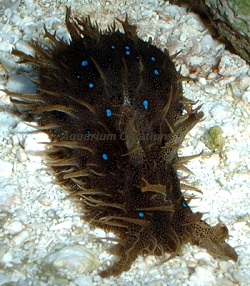Orange Dragon Sea Slug
Elysia crispata

Description:
Body translucent to opaque white with a reticulate pattern of orange or orange-red. Similar in shape to other species of the genus ans swims by lateral flexion of the body when disturbed.
Tank Recommendations:
Aquarium Pump intakes, wavemakers, and drains must be screened so harm can't come to the Lettuce Sea Slug, so care should be taken to screen these off. Like all invertebrates they are sensitive to higher levels of nitrates and can not tolerate any copper based medications.
Food and diet:
Omnivore
Level of Care:
Difficult
Acclimaton Time:
1+ hours
Reef Compatibility
:Yes
Approximate Purchase Size:
1-1/2" to 3"
|
|
Banana Sea Slug
Notodoris minor

Description:
Also known as Banana Nudibranch, Banana Sea Slug, Banana Slug, Pineapple Notodoris, Pineapple Nudibranch and Pineapple Sea Slug. Found singly or in pairs on coral and rocky reefs amongst sand and rubble areas. Found in the Indo-Pacific.
Tank Recommendations:
Aquarium Pump intakes, wavemakers, and drains must be screened so harm can't come to the Lettuce Sea Slug, so care should be taken to screen these off. Like all invertebrates they are sensitive to higher levels of nitrates and can not tolerate any copper based medications.
Food and diet:
Omnivore
Level of Care:
Difficult
Acclimaton Time:
1+ hours
Reef Compatibility
:Yes
Approximate Purchase Size:
1" to 2-1/2"
|
|
Blue Velvet Sea Slug
Casella atromarginata

Description:
The Blue Velvet Sea Slug, Casella atromarginata, also known as the Blue Velvet Nudibranch and the Head Sheild Sea Slug, features a beautiful blue and black body with electric blue highlights around its edges. Velvet Slugs are best kept in an aquarium with Flatworm problems. Mostly nocturnal, these cryptic slugs will spend their waking time cleaning up problematic flatworms and will disappear when they are no longer in the aquarium.
Tank Recommendations:
Aquarium Pump intakes, wavemakers, and drains must be screened so harm can't come to the Lettuce Sea Slug, so care should be taken to screen these off. Like all invertebrates they are sensitive to higher levels of nitrates and can not tolerate any copper based medications.
Food and diet:
Specific feeder on flatworms. Will not likely eat enough of anything else and will slowly starve in an aquarium without this food source.
Level of Care:
Difficult
Acclimaton Time:
1+ hours
Reef Compatibility
:Yes
Approximate Purchase Size:
1" to 2"
|
|
Blunt-end Sea Hare
Dolabella auricularia

Description:
The Blunt-end Sea Hare (Dolabella auricularia) is from a family of sea hares with a slightly different appearance than many of the more common Aplysia sp. sea hares found in the aquarium trade. Their back end has a flat "disk" surrounded by a short fringe. These sea hares have a mottled green or brown appearance and can blend in very well with rockwork and algae. Sea Hares are sought after for their voracious appetites, feeding on macro and filamentous algae. They will feed on dried algae if the live algae supply dwindles and should be fed to avoid starvation. These slugs are reef safe and will not eat corals or polyps
Tank Recommendations:
Aquarium Pump intakes, wavemakers, and drains must be screened so harm can't come to the Lettuce Sea Slug, so care should be taken to screen these off. Like all invertebrates they are sensitive to higher levels of nitrates and can not tolerate any copper based medications.
Food and diet:
A herbivore, if regular feedings of Algae are not possible from growth in the aquarium, it will need a supplemented diet of lettuce or dried sea weed.
Level of Care:
Moderate
Acclimaton Time:
1+ hours
Reef Compatibility
:Yes
Approximate Purchase Size:
2" to 3"
|
|
Blue Dot Sea Hare
Bursatella leachii

Description:
Known in the aquarium trade as the Blue Spot Sea Hare or Blue Dot Sea Hare, the Bursatella leachii is a popular sea hare from Indo Pacific waters. The entire body is covered with frilly, ragged appendages that can resemble the blades of some types of macroalgaes. Covered with bright metallic blue spots on a dark brown body, they usually grow to between 2 to 3 inches.
Tank Recommendations:
The Blue Dot Sea Hare is not often seen in the aquarium trade. It should be housed in a tank with live rock and a healthy population of algae. Aquarium Pump intakes, wavemakers, and drains must be screened so harm can't come to the Lettuce Sea Slug, so care should be taken to screen these off. Like all invertebrates they are sensitive to higher levels of nitrates and can not tolerate any copper based medications.
Food and diet:
A herbivore, if regular feedings of Algae are not possible from growth in the aquarium, it will need a supplemented diet of lettuce or dried sea weed.
Level of Care:
Moderate
Acclimaton Time:
1+ hours
Reef Compatibility
:Yes
Approximate Purchase Size:
1" to 2"
|
|
|





